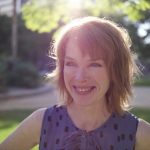Pushed Out of the Nest
The surprising challenge when your spiritual home closes
Illustration Credit: White Moths by Amy Alice Thompson
I stared in disbelief at the email. Golden Bridge was closing? I would need to use up my classes before the end of the month? Whoa. I felt like I’d been kicked in the stomach.
Golden Bridge Yoga Center had been a beacon in our Hollywood neighborhood, anchored by the legendary Kundalini teacher Gurmukh Kaur Khalsa. It was my church, my temple, my spiritual navel. When I went to a sadhana (daily practice), I always left feeling joyful and calm. The building itself was glorious, too, with high ceilings, exposed brick, and Moroccan lamps. But the rent was high, and Gurmukh is on the road teaching 300 days a year. So this beloved studio was shuttered, and in the days and months that followed, I felt surprisingly bereft. Judging from the conversations I’ve had, my fellow yogis were just as stunned and saddened. It turns out that the loss of a spiritual center can be a very similar experience to the death of a loved one.
“There can be an enormous sense of loss,” says Dr. Christine Pohl, professor of Christian ethics at Asbury Theological Seminary and author of the book Living into Community: Cultivating Practices That Sustain Us. “There can be a sense of betrayal, like ‘We were going to do this together, and now we’re not.’ That’s a wrenching feeling. Sometimes there is anger; certainly there’s disappointment. There’s a loss of a shared history and a loss of a shared future.”
Pohl says she has seen these emotions bubble up in many communities, especially in small, rural churches. “The church may get smaller and smaller until it’s unsustainable. Six or eight people might be left, but they are still resistant to closing the church. People have a long history with a place.”
In Judaism, there’s a notion, makom kavuh, that a person should have a fixed place to pray, explains Rabbi Rona Shapiro, of Congregation B’nai Jacob in Woodbridge, Conn. “Anyone who engages in a regular spiritual place experiences that. People sit in the same spot in the synagogue, week after week. ‘I want to pray in the same place.’ When you are displaced, that center is pulled out from under you.”
Shapiro should know. She helped steer a former congregation in Cleveland through a difficult merger in 2011. That temple was clearly struggling. “There was a week when the lights were out, the heat was off,” she says. She and a committee began speaking with other nearby synagogues and wound up merging with a temple that was less than a mile away. Still, it wasn’t easy on the 225 families involved.
They were disturbed, Shapiro says. “Their home was going, even though I was the rabbi and trying to frame it as ‘we’re still going to be together and this will be good for us.’ For many people it was a good thing, because the other synagogue was falling apart. But some people felt like what they had—which was sweet and precious and had been built with their hands—was all vanishing. They were right when they said it was never going to be the same again. But that’s true of life, isn’t it?”
Moving On
Building new relationships, connections, and community takes time, says Pohl. Congregation members are not just attached to a place, but also to a leader. “They locate a deep sense of trust with their pastor,” she says. “It’s not easy to shift those feelings until that new pastor has proved themselves trustworthy. That can take years.”
Some people are afraid to try a new spiritual experience for fear of being hurt, much in the same way a person might be afraid to date again after being widowed. But for Marlene Passaro, who had been the executive director at Golden Bridge, time was
of the essence in establishing a new community. “It was difficult to see people in so much pain,” she says. “I thought of my very first Kundalini classe and how it had saved my life and I thought, ‘I have to keep this flame lit! This can’t wait. It has to be now, like this week.’”
She and several partners who she knew via Golden Bridge immediately started a new studio, Daily Love Yoga, and now have a roster of teachers and a week’s schedule of classes and workshops, all in the same Hollywood neighborhood she so loves. “I knew that the closing of Golden Bridge was an opportunity for transformation,” she says. “There was never a choice.”
The faithful are flexible, says Rabbi Shapiro. “It’s not that we can’t reestablish. We’re like birds. We make new nests.”
Practice
How My Spiritual Training Moved to My iPhone
“A train you could ride, at speed, across the countryside, was my own secret spiritual place, because it was window to a world outside, but a thoughtful one, a reflective one,” says Bob Zenk, a writer and narrator based in Seattle. “If I needed to open my soul and find the spirit of me at my most alive, I would buy a ticket on a train.” But transportation changed, the American landscape changed, and it’s hard for Zenk to find that train Zen anymore.
“My spiritual place was a moving place, and it moved away,” he says. He’s come up with a novel solution: He listens to the “Sleep on a Train” recording on
his iPhone, set to repeat, whenever he needs comfort, solitude, or rest.


